Endangered Archaeology in the Middle East & North Africa
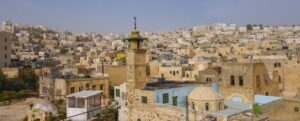
By: Grace Friar/Arab America Contributing Writer
The United Nations Educational, Scientific and Cultural Organization, or UNESCO, seeks to build peace through international cooperation in Education, the Sciences and Culture. The general public knows about world-famous UNESCO sites like the Taj Mahal, the Great Barrier Reef, the Acropolis, and many more as they reflect the greatest feats in human history and stand as a reminder of culture and traditions. In order to receive World Heritage status, sites must meet at least one of ten selection criteria, all relating to human tradition, culture, heritage, and genius.
World Heritage sites receive support and funds from UNESCO to preserve and protect value and integrity, but funds and conservation can only do so much. Natural forces like erosion and disasters are inevitable as well as other dangers from humans like conflict and construction. World Heritage sites can be directly impacted by a variety of dangers that cannot necessarily be avoided, which leaves the threat of destruction and even the possibility of disappearance from history, especially the less popular ones. The following is a presentation of lesser-known sites in the Middle East and North Africa along with their significance and the threats endangering their existence.
Cairo’s City of the Dead – Egypt
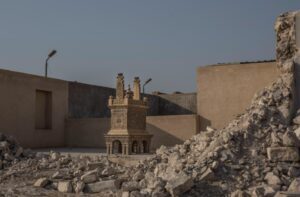
Recently, Cairo’s City of the Dead has reached the news as it is being impeded upon by government-built highways and overpasses. This construction is presented as part of a nationalist vision of a new ‘solidly suburban’ Egypt with better-connected suburbs and less traffic choking a city of some 20 million people.
The City of the Dead is a 3km long stretch of land outside Cairo’s Old City with a Northern Cemetery and Southern Cemetery. Each of these cemeteries traces not only to Roman-era Christianity, but to various Muslim dynasties as well. The culture surrounding the way of life in this area is best put by Dina Bakoum, an art historian specializing in heritage conservation and management, as she says “It’s a city of the dead, but it’s a living heritage.” People living here have developed a way of life intertwined with the identity of the City of the Dead, and these new highways are disrupting that as important structures are being disrupted and bridges are being built, quite literally, through homes.
The government and Supreme Council of Antiquities say no registered monuments were or will be harmed in the process of construction as most graves are from the 1920s and 1940s, all belonging to individuals and families that will be compensated. Antiquities experts have stated that the damage will be done to monuments that are not on a ‘limited’ list but still have enormous historical or architectural value.
Abu Mena – Egypt
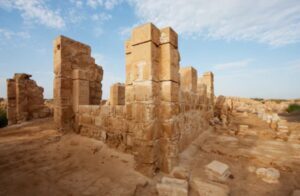
Nearly 50km south of Alexandria lies the city of Abu Mena, the remains of an early Christian holy city where Saint Menas, a martyr who died 296 AD, is said to be buried. In the city lies a church, baptistery, basilicas, public buildings, streets, monasteries, houses, and workshops that have all been remarkably preserved despite the city being abandoned around the 10th or 11th centuries. The Basilica of Arcadius was built in the 5th century and is the only Coptic monument with strong Egyptian and Byzantine architectural influences, referencing a once thriving and diverse population.
Hebron/Al Khalil Old Town – Palestine
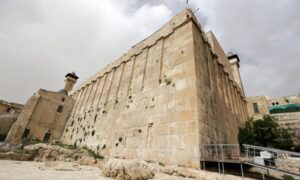
Palestine’s Site of Hebron/Al Khalil Old Town sits in Israeli occupied West Bank and the granting of UNESCO’s World Heritage status remains controversial. The 12 to 3 vote, with 6 abstentions, noted this site as Palestinian territory which Rula Maayah, Palestine’s Tourism Minister, called a win as the Old Town and historic mosque “historically belong to Palestinian people.” The granting of World Heritage status grants immediate allocation of World Heritage funds, and it is also fast-tracked because the city is deemed under threat as Palestinians accuse Israelis of an alarming number of violations like vandalism and other damage.
Dating back more than 5,000 years, this site is said to be one of the oldest cities in the world with extreme importance to both Jewish people and Muslims. The Old Town is a host to the Tomb of the Patriarchs, or the Ibrahami Mosque, which is said to be the final resting place of Abraham, Isaac, and Jacob.
Site of Palmyra – Syria
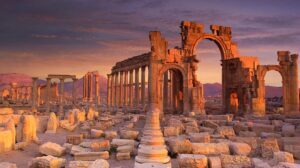
Syria’s site of Palmyra is one of six World Heritage sites on the endangered list within the country, mostly all due to threat of destruction in the path of war. Before 2011, Palmyra was on the list due to the weathering of structures from humidity and temperatures, but in 2014 ISIS gained control of the area. During this time looters stole artifacts and sold them, giving a part of the proceeds to ISIS, a process which has supplied ISIS with hundreds of thousands of dollars. The area was taken back by the Syrian government in 2016 and since then, around 2500 people, most archaeologists, have safely preserved around 300,000 objects. Despite the fruitful efforts to save artifacts, structures like arches and tombs cannot be moved safely and the city is said to be almost 60% destroyed.
Palmyra was built almost over 2000 years ago and dates back to the 19th century BCE. This city was a capital of social and cultural diversity as its placement between the Mediterranean Sea and Euphrates River connected Romans with Mesopotamia as well as Persia, India, and China. The city’s architecture reflects Roman and Persian styles as well as different religions with temples and dedications to Phoenician, Babylonian, and Ancient Arab gods.
Old City of Sana’a – Yemen
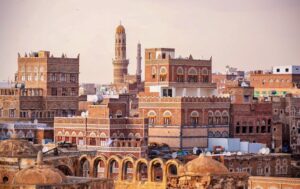
The Old City of Sana’a has been inhabited for over 2500 years with historical significance as a trading route town in the 1st century A.D. and a major center for the spread of Islam in the 7th and 8th centuries. This town holds 103 mosques, 14 hammams, and over 6000 homes all built before the 11th century. Perhaps the greatest landmark here is the Great Mosque, which was the first mosque to be built outside Mecca and Medina and is said to have been built when the Prophet Mohammed was still alive. It was here that one of the oldest copies of the Qur’an was found. The Old City of Sana’a was granted World Heritage status in 1986 for three clearly outlined reasons: the homogenous architectural ensemble resembles early Islamic culture, the city has a direct relationship with history and the spread of Islam, and the preserved houses represent a traditional human settlement.
Civil unrest caused by the presence of Al Qaeda and civil war have threatened the site as it felt the repercussions of war from bombs and airstrikes, however, the most dangerous threat to this important city comes from new land developments. In 1969, this city became the country’s new capital which brought an enormous spike in the population that the infrastructure just could not handle. Inadequate drainage systems for water and sanitation have threatened the structural integrity of many buildings, and salt deposits from deteriorating concrete ruins traditional housing materials and leads to collapse. The structures built in an attempt to accommodate the influx of new citizens, namely concrete buildings, hotels and cell phone towers, have also been described as eyesores that ruin the visual integrity of this ancient city.
Check out Arab America’s blog here!








